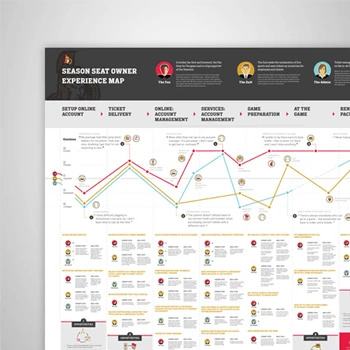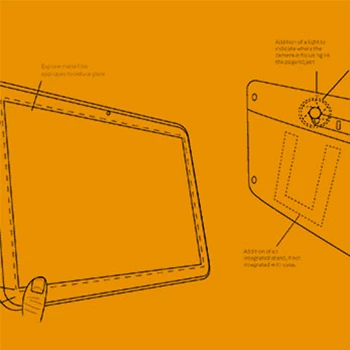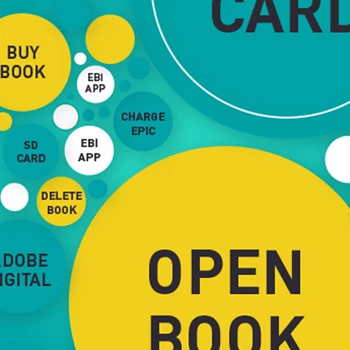What is brand experience design and how does it differ from traditional branding?
Brand experience design goes beyond visual identity to create emotional connections through every customer touchpoint. While traditional branding focuses on logos and messaging, brand experience design encompasses the complete journey of how audiences encounter, interact with, and remember your organization across all channels and interactions.
Tip: Evaluate whether your current branding creates consistent emotional experiences across all touchpoints or if it's primarily focused on visual identity without considering the broader customer experience.
How does Experience Thinking apply to brand strategy development?
Experience Thinking positions brand experience as the foundational layer that informs all other experiences - content, product, and service. Our approach ensures your brand promise aligns with actual customer experiences, creating authentic brand relationships built on consistent delivery rather than empty marketing assurances.
Tip: Start brand development by defining what experience you want customers to have with your organization, then work backward to create brand elements that support and reinforce that experience.
Why is brand experience considered foundational to other experience types?
Brand experience establishes the emotional and value context that audiences bring to every interaction with your organization. Before customers use your products or services, they encounter your brand, which shapes their expectations, perceptions, and willingness to engage with everything else you offer.
Tip: Ensure your brand strategy is completed before beginning product, content, or service design initiatives to provide clear guidance for all subsequent experience development.
What's the difference between brand promise and brand experience?
Brand promise is what you commit to deliver to your audience, while brand experience is how consistently you actually deliver on that promise over time. Strong brands align promise with experience - what you say matches what customers actually experience through every interaction with your organization.
Tip: Audit your current brand promises against actual customer experiences to identify gaps where promises aren't being fulfilled consistently across all touchpoints.
How do you measure brand experience effectiveness?
Brand experience measurement includes brand awareness, perception studies, emotional response tracking, customer loyalty metrics, and brand equity assessments. We also measure consistency across touchpoints and the alignment between intended brand experience and actual customer perceptions.
Tip: Establish baseline brand perception measurements before launching new brand experiences to demonstrate the impact of brand improvements on customer relationships and business outcomes.
What role does brand persona play in experience design?
Brand persona captures your organization's personality through human traits and characteristics, similar to customer personas but focused on how your brand should behave and communicate. This persona guides tone of voice, visual style, interaction principles, and decision-making across all brand touchpoints.
Tip: Develop a detailed brand persona that includes not just personality traits but also how those traits translate into specific behaviors and communication styles across different situations.
How does brand architecture support complex organizations?
Brand architecture defines relationships between master brands, sub-brands, product brands, and service brands within your organization. It provides structure for consistent brand experience while allowing for appropriate differentiation across different offerings, markets, or audiences.
Tip: Map your current brand portfolio to identify inconsistencies or confusion points, then create architecture that clarifies relationships while reducing customer cognitive load.
What's your process for brand strategy development?
Our brand strategy process includes discovery (brand environment audit, audience research, competitive analysis), strategy (brand persona, positioning, promise, value proposition, architecture), design (concept, identity, system), and implementation (delivery, management). Each phase builds on previous insights to create authentic brand experiences.
Tip: Plan for brand strategy development to take sufficient time for proper research and stakeholder alignment rather than rushing to visual design before strategy is solidified.
How do you conduct brand environment research and competitive analysis?
Brand environment research examines your audience, competitive landscape, and industry context through surveys, interviews, market analysis, and brand audits. We analyze not only direct competitors but also brands from adjacent markets that influence audience expectations and perceptions.
Tip: Include competitive analysis of brands outside your industry that your audience admires to understand expectation benchmarks that may influence how they perceive your brand.
What role does audience research play in brand strategy?
Audience research reveals the motivations, values, preferences, and behaviors of people you want to reach through your brand. This research informs brand positioning, messaging, visual direction, and experience design to ensure your brand resonates authentically with target audiences.
Tip: Conduct audience research that goes beyond demographics to understand psychographics, values, and emotional triggers that influence brand relationships and loyalty.
How do you develop brand positioning that differentiates effectively?
Brand positioning defines your unique value in the market by identifying what you stand for, who you serve, and why you're different. We develop positioning through competitive analysis, audience insights, organizational strengths assessment, and market opportunity identification.
Tip: Test brand positioning concepts with target audiences to ensure your intended differentiation is meaningful and believable to the people you want to reach.
What's your approach to value proposition development?
Value proposition articulates the specific benefits and outcomes your organization delivers to customers. We develop value propositions by understanding customer needs, organizational capabilities, competitive alternatives, and the unique intersection where you provide superior value.
Tip: Frame value propositions in customer language focused on outcomes they care about rather than internal capabilities or features that may not resonate with their priorities.
How do you ensure brand strategy aligns with business strategy?
Brand strategy must support and enable broader business objectives rather than operating independently. We align brand strategy with business goals, market positioning, growth plans, and organizational capabilities to ensure brand investments drive business results.
Tip: Involve senior leadership in brand strategy development to ensure brand decisions support business priorities and receive necessary organizational commitment and resources.
What stakeholder engagement approaches do you use for brand strategy?
Stakeholder engagement includes leadership interviews, cross-functional workshops, collaborative analysis sessions, and structured feedback processes. We ensure all relevant perspectives inform brand strategy while building organizational consensus around brand direction and priorities.
Tip: Include diverse stakeholder perspectives in brand strategy development while keeping decision-making authority clear to avoid paralyzing conflicts between different viewpoints.
What's your approach to brand naming and logo design?
Brand naming begins with brand strategy workshops to generate concepts, followed by creative development, stakeholder reduction processes, and audience testing for memorability and distinctiveness. Logo design follows naming, creating visual symbols that reflect brand strategy while being distinctive, memorable, and timeless.
Tip: Keep naming and logo decision-making groups small to avoid design-by-committee problems while using audience testing as input rather than final decision-making authority.
How do you develop tone of voice and key messaging?
Tone of voice captures how your brand sounds through personality traits like formal, casual, passionate, or professional. Key messaging conveys what audiences need to hear about your value, differentiators, and reasons to choose you. Both emerge from brand persona and positioning strategy.
Tip: Create specific tone of voice guidelines with examples of what to say and what not to say in different situations rather than abstract personality descriptions.
What elements comprise a complete brand identity system?
Complete brand identity includes naming, logo, tagline, color palette, typography, tone of voice, key messaging, imagery style, and application guidelines. These elements work together to create consistent brand recognition and experience across all touchpoints and communications.
Tip: Develop brand identity elements that work effectively across both digital and physical applications rather than optimizing only for one medium.
How do you ensure brand identity works across different cultural contexts?
Cultural adaptation requires understanding color symbolism, typography preferences, communication styles, and cultural values in different markets. We design flexible brand identities that maintain core recognition while allowing for appropriate cultural customization.
Tip: Plan for cultural adaptation during initial brand identity development rather than trying to retrofit existing identity for international markets later.
What's your approach to brand identity testing and validation?
Brand identity testing examines distinctiveness, memorability, emotional response, and first impressions through focus groups, surveys, and interviews. We test identity concepts with target audiences and key stakeholders to validate effectiveness before final implementation.
Tip: Test brand identity in realistic contexts where audiences will actually encounter it rather than in isolation to understand how it performs in competitive environments.
How do you handle brand identity evolution and refresh needs?
Brand identity evolution balances maintaining equity and recognition with staying relevant and contemporary. We assess when refresh is needed, what elements to preserve versus update, and how to evolve identity while maintaining brand continuity and customer relationships.
Tip: Establish brand identity review cycles that examine relevance and performance before identity becomes outdated rather than waiting for brand problems to emerge.
What intellectual property considerations apply to brand identity?
Brand identity IP includes trademark research, domain availability, social media handles, and design ownership rights. We ensure brand elements can be legally protected and used across all intended applications and markets without infringement issues.
Tip: Conduct comprehensive trademark and domain research early in naming and identity development to avoid costly changes after creative work is completed.
What's included in a comprehensive brand design system?
Brand design systems include identity elements, brand patterns showing applications, detailed usage guidelines, style guides for different contexts, application templates, and governance processes. The system enables consistent brand experience while providing flexibility for different contexts and needs.
Tip: Design brand systems that are comprehensive enough to guide decisions but simple enough that teams will actually use them rather than creating overly complex systems that get ignored.
How do you develop brand patterns and applications?
Brand patterns show how identity elements work in different contexts - on products, in spaces, across digital platforms, in communications. Brand applications are specific, well-defined uses like business cards, websites, packaging, and marketing materials that demonstrate proper brand implementation.
Tip: Create brand patterns for the contexts where your brand will actually be used rather than generic applications that may not address your specific implementation needs.
What specialized brand guides do you create for different touchpoints?
Specialized guides include web style guides, social media guidelines, corporate communications standards, customer service scripts, interior design specifications, and product packaging requirements. Each guide translates core brand principles for specific application contexts.
Tip: Prioritize creating specialized guides for your most important or most frequently used brand touchpoints rather than trying to create guides for every possible application simultaneously.
How do you ensure brand system scalability across growth?
Scalable brand systems include flexible frameworks, modular components, clear decision-making principles, and governance processes that enable consistent brand application as organizations grow, add products, enter new markets, or expand touchpoints.
Tip: Build brand systems with growth scenarios in mind, including how the system will accommodate new products, markets, or organizational structures you anticipate.
What's your approach to brand system governance and compliance?
Brand governance includes approval processes, quality control systems, training programs, compliance monitoring, and enforcement mechanisms. We establish governance that maintains brand consistency without creating barriers to efficient operations and creative expression.
Tip: Design brand governance processes that educate and empower rather than restrict, helping teams understand why brand consistency matters and how to achieve it.
How do you handle brand system evolution and updates?
Brand system evolution includes regular performance reviews, user feedback collection, application gap identification, and systematic updates. We create processes for system maintenance that keep brand guidelines current with organizational needs and market changes.
Tip: Establish regular brand system review cycles to keep guidelines current and relevant rather than letting systems become outdated and ignored over time.
What digital tools and platforms support brand system management?
Digital brand management includes online style guides, asset libraries, template systems, approval workflows, and compliance monitoring tools. We recommend and implement platforms that make brand compliance easier while providing access to current brand resources.
Tip: Choose brand management platforms that integrate with your team's existing workflows rather than requiring them to learn entirely new systems that may not be adopted.
How do you support brand implementation across different channels?
Brand implementation includes digital platforms, print materials, packaging, signage, interior design, merchandise, social media, and communication channels. We provide implementation guidance, quality control, and ongoing support to ensure consistent brand delivery across all touchpoints.
Tip: Prioritize implementation support for your highest-impact brand touchpoints first rather than trying to implement everything simultaneously without proper quality control.
What's your approach to brand launch and rollout planning?
Brand launch planning includes stakeholder communication, timeline coordination, implementation prioritization, training delivery, and performance monitoring. We ensure brand launches create maximum impact while maintaining operational continuity and quality standards.
Tip: Plan brand launches with sufficient lead time for proper implementation rather than rushing launches that may compromise brand experience quality.
How do you train organizations for brand implementation?
Brand training includes workshops for key stakeholders, detailed guideline walkthroughs, hands-on application sessions, and ongoing support resources. We ensure teams understand not just how to use brand elements but why brand consistency creates value for the organization.
Tip: Provide brand training that connects brand guidelines to business outcomes rather than treating brand compliance as arbitrary rules that teams must follow.
What ongoing brand management support do you provide?
Ongoing support includes brand performance monitoring, application review, guideline updates, compliance consulting, and team coaching. We help organizations maintain brand quality while building internal capability for sustained brand management.
Tip: Establish ongoing brand management capabilities within your organization rather than relying solely on external support to maintain brand consistency over time.
How do you measure brand implementation success?
Implementation success measurement includes brand consistency audits, stakeholder adoption rates, application quality assessments, customer recognition metrics, and business impact indicators. We track both compliance and effectiveness to ensure brand implementation drives intended results.
Tip: Measure brand implementation success through customer perception and business outcomes rather than only internal compliance metrics to ensure brand work creates external value.
What's your approach to brand compliance monitoring?
Brand compliance monitoring includes regular audits, quality control processes, feedback systems, and corrective action procedures. We balance consistency requirements with operational efficiency to maintain brand standards without hindering business operations.
Tip: Focus compliance monitoring on brand touchpoints that most significantly impact customer perception rather than trying to monitor every brand application with equal intensity.
How do you handle brand implementation in complex organizational structures?
Complex implementation requires understanding organizational dynamics, establishing clear accountability, creating coordination processes, and providing appropriate autonomy for different business units while maintaining overall brand coherence.
Tip: Map organizational decision-making and implementation responsibilities early to identify potential coordination challenges and design appropriate governance structures.
What's your approach to corporate communication and report design?
Corporate communication design creates impactful reports that convey brand values, accomplishments, and messages effectively to stakeholders, shareholders, and the public. We design annual reports, ESG sustainability reports, and corporate communications that reinforce brand experience while communicating important information clearly.
Tip: Use corporate communications as brand experience opportunities rather than treating them as purely informational documents that exist separate from your brand strategy.
How do you approach brand packaging design?
Brand packaging design creates visually captivating packages that stand out from competitors, convey value proposition, and capture customer attention while reinforcing brand experience. We balance aesthetic impact with functional requirements and production constraints.
Tip: Consider packaging as a critical brand touchpoint that can influence purchase decisions and customer experience rather than just functional product protection.
What's your approach to corporate identity for complex organizations?
Corporate identity captures authentic organizational personality and brand essence in dramatically engaging visual systems. For complex organizations, we create flexible identity systems that work across different business units, markets, and applications while maintaining coherent brand experience.
Tip: Design corporate identity systems that can accommodate organizational complexity while remaining simple enough for consistent implementation across different contexts.
How do you create effective infographics and data visualization?
Infographic design captures attention, improves engagement, and increases comprehension by visually representing complex information. We create data visualizations that support brand experience while making complex information accessible and actionable for target audiences.
Tip: Focus infographic design on telling compelling stories with data rather than just making information visually attractive without improving understanding or engagement.
What's your approach to brand experience in physical environments?
Physical environment brand experience includes interior design, signage systems, spatial layout, and environmental graphics that reinforce brand experience through three-dimensional spaces. We ensure physical environments communicate brand personality and values while supporting functional requirements.
Tip: Consider how physical environments make people feel about your brand rather than focusing only on functional space requirements or aesthetic preferences.
How do you handle brand experience for digital products and platforms?
Digital brand experience integrates brand identity with user interface design, interaction patterns, content strategy, and user experience design. We ensure digital platforms reinforce brand experience while prioritizing usability and user goal achievement.
Tip: Balance brand expression with functional usability in digital products rather than letting brand considerations compromise user experience quality.
What's your approach to sound branding and audio identity?
Sound branding develops brand identity through audio elements, music themes, and sound effects that create emotional associations and brand recognition. We create audio identities that complement visual brand elements while establishing distinctive sonic brand experiences.
Tip: Develop cohesive sound branding themes that work across different audio contexts rather than selecting isolated sound effects without considering overall audio brand experience.
How do you integrate AI technologies into brand experience design and management?
AI integration enhances brand experience through personalized content generation, automated brand compliance monitoring, intelligent asset management, and dynamic brand adaptation based on audience behavior. We ensure AI applications strengthen rather than dilute brand authenticity while maintaining human creativity and strategic oversight in brand decision-making.
Tip: Use AI to augment human brand creativity and efficiency rather than replacing strategic brand thinking, ensuring AI applications support authentic brand expression and customer relationships.
What role does AI play in brand content creation and personalization?
AI enables scalable brand content creation, personalized messaging, dynamic visual adaptation, and automated brand compliance checking. We implement AI tools that maintain brand consistency while enabling efficient content production and personalized brand experiences at scale.
Tip: Establish clear brand guidelines and approval processes for AI-generated content to ensure automated brand applications maintain quality and authenticity standards.
How do you ensure AI-powered brand experiences remain authentic and human?
Authentic AI brand experiences require human oversight, clear brand personality guidelines, emotional intelligence integration, and maintaining genuine connection points between brands and audiences. We balance AI efficiency with human creativity to preserve brand authenticity and emotional resonance.
Tip: Use AI to handle routine brand applications while preserving human control over strategic brand decisions and emotionally significant brand interactions.
What's your approach to AI-assisted brand strategy and insights?
AI assists brand strategy through market analysis, audience behavior prediction, competitive intelligence, and performance optimization. We use AI to enhance strategic thinking and decision-making while ensuring human judgment guides brand direction and creative vision.
Tip: Leverage AI for brand data analysis and trend identification while maintaining human strategic oversight for brand positioning and creative direction decisions.
How do you handle brand compliance and quality control with AI tools?
AI brand compliance includes automated guideline checking, asset management, usage monitoring, and quality assessment. We implement AI systems that help maintain brand standards while reducing manual oversight burden and enabling faster brand implementation.
Tip: Implement AI compliance tools that flag potential brand issues for human review rather than making automatic corrections that might compromise brand expression quality.
What ethical considerations apply to AI in brand experience?
AI brand ethics include transparency about AI usage, avoiding deceptive personalization, respecting audience privacy, and maintaining honest brand representation. We ensure AI brand applications build rather than undermine trust between brands and audiences.
Tip: Be transparent about AI usage in brand communications and ensure AI personalization provides genuine value rather than manipulative or invasive brand experiences.
How do you prepare brands for future AI developments and opportunities?
AI readiness includes building flexible brand systems, establishing AI governance frameworks, developing internal AI literacy, and creating experimentation processes. We help brands prepare for emerging AI capabilities while maintaining focus on current brand priorities and customer relationships.
Tip: Build brand AI capabilities gradually through pilot projects rather than waiting for perfect AI strategies, ensuring learning and adaptation as AI technology continues evolving rapidly.












